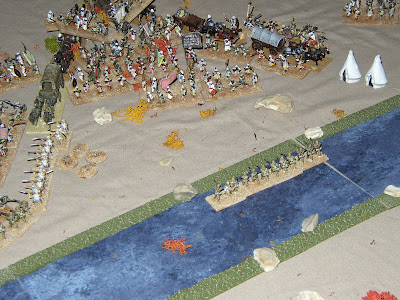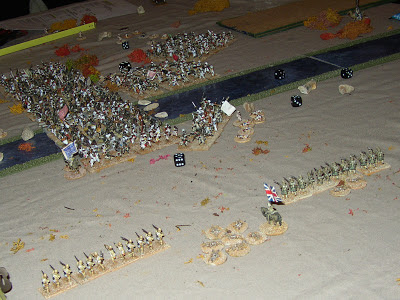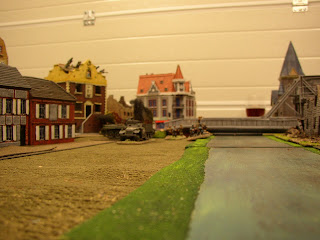For our club’s regular Monday game I ran a Sudan version
of the Battle of Intombe River on 19th Nov 2012. The chap with all the Zulu stuff was otherwise
engaged and as all I have is the Sudan
stuff it made sanse as it was within period.
We use Battles For Empire for out Colonial rules by Chris
Leach as they seem to produce a game that for us feels right for the period.
There is a yahoo group for discussion on the rules and also said scenario in
the files section.
I set the table up as per the scenario, the scenario allows
the Brits some leeway in deploying tents but for a first go we did it
‘properly’. We used a 6by4 table with 15mm figures, my Imperial are based 3 to
a stand and each stand is 3cm wide, natives are 5 to a stand and each stand 6cm
wide. Each unit has 4 stands meaning an Imperial line (4by1) matches a massed
foot formation (2by2). Each pair of tents represents a commander or unit for
the British, the rocks in the river show the location of the ford.
Alan Millicheap led the Dervish on the left, Rodger Williams
running the centre and Alan Paull of Suprised Stare Games on the right. Shaun
Mutton of Dreamholme Scenics took the British north bank, a hospital pass if
ever there was one, whilst Graham Bevan took the south bank; their mission is
to get of the south edge of the board with 3 units (so get 1 off the north bank
to the south), the dervish just have kill 4 units thus prevent 3 escaping.. I
umpired, took pictures and generally had a great time.
The Dervish deployed right up tight to their allowed
distance on to the table so only cataclysmic results would prevent a historical
opening of the battle. The Dervish now won the first of many critical
initiative rolls and charged.
Initiative in BFE can be critical at certain times in that
you may want to get away or force your opponent to take his Unit Conduct Chart (UCC)
tests before you. In this case it’s important as the Brits have to try and wake
but if the Dervish move first they can be on to Brits in turn 1 (which is
historical). Sure enough Captain Moriaty outside the apex of the laager was
overrun in turn 1. A unit on the left flank was also hit with a rude awakening
whilst the rest of the Dervish tore through the larger. The Brits did manage to
wake the units on the south side, one in the middle of the laager and one on
the left flank.
The Dervish start with 10 units out of 30 on the table,
dicing twice for reserves each turn from the 2nd onwards; I used the
Zulu reserve charts so we could replicate the Zulu Chest, horns and Loins
tactics that the scenario dictates. As it happens we could have saved time and
given all the reserves to Alan as on turn 2 he managed to get 2 lots of 3 units
on to the left horn for himself (top right of picture).
This continued for most of the game until the last couple of
moves when the Loin chart was finally activated and Rodger got a couple of
units in the centre. Alan Paull got no reserves but his team graciously let him
have some of theirs.
Whilst the Dervish now poured through the laager one British
unit take the sensible precaution of backing off to the other side of the bank.
Meanwhile the loud screaming and gunfire appears to be insufficient to wake a
unit of British. The British on the south bank elect to retire to try meet
their victory conditions.
Turn three see one British units wiped out whilst the one on
the far left comes under attack. The British on the right finally wake after
the Dervish actually clamber into the tents and set about. The unscathed unit
continues to negotiate the swollen ford.
The sleepy British lose their unit on the right but the
south bank units realise they only way to win is to ensure 1 unit gets of the
north bank so they push back up to provide covering fire. The British to the
left see off a unit of Dervish as the initiative roll becomes all important
again. The Dervish are no in a position to catch the unit in the river if they
move first.
The Brits win the initiative and the unit makes it over the
river to join the other 2 units. Meanwhile the last British unit on the north
bank is dispatched. And the Dervis pour across the river.
Interpenetration in these rules is limited so it’s important
to ensure commanders are in the correct place to affect UCC rolls and the order
of picking units requires some thought. The mass of troops often means a log
jam for the native troops in these rules and this scenario was no exception for
the Dervish trying to follow the Brits across the ford; co-ordination is key.
Of course it wasn’t help by yet more reserves arriving at the Devish left horn,
all trying to get to the river.
The trick for the British is now to stall the Dervish by
having the lead units fail UCC rolls and paralysed as a result, this would mean
the Dervish would be stuck and those behind also stuck. Catch-22 is that to do
this they need to score hits and accumulated hits result in destruction of the
unit thus clearing the way for other units to plough through. So it is a meat
grinder but actually quite tense as if the Dervish can contact the retreating
line and cause hits the British will crumble due to attrition.
As it happen the Dervish now get a unit across and crash
into the line .
Volley fire sees said unit trashed at no cost to the British
line.
Calamity now for the British. Using commanders to boost the
UCC result the Dervish get 2 fanatical charges as they exit the river and they
smash into the thin red line. Desperate point blank fire and hand to hand
combat see both the fanatic charges destroyed but the central British unit took
a beating and is on 7 hits, 8 and it gets destroyed.
The British kept gradually retreating but did not take
measure to protect the damage unit, mind you, with 7 hits it would struggle to
get a decent UCC result to escape anyway.
More Dervish now pour across the ford.
Those units are shot down in an astounding round of firing
by the British and destroyed. However it reopen the space for more Dervish to
race forward. Meantime the Dervish have instigated a ticketed queuing system on
the north bank so that the fording is orderly….
More devastating fire decimates the Dervish but there’s
thousands of ‘em and they are now out of the river in force….
And eventually numbers tell. Despite taking 7 hits on the
way in a Dervish unit hits the central British and scores that all important
last hit to wipe out the 4th unit.
So a win for the Dervish and pretty much spot on to the
historical result. In reality some troops did make good their escape but not
thanks to Lieutenant Harward on the south bank who ran off and left them, nor
Captain Moriaty whose incompetence got him killed right at the start of the
battle.
The scenario does have to potential to look like it’s a case
of mowing down natives but no more so than playing Rourke’s Drift. The odds do
not favour the British at all and they need the first initiative and to get
everybody awake then they could possibly sacrifice 2 units on the north and
escape with the rest, but that’s a lot of luck needed. Re-positioning the tents
and making the laager effective (as was recommended historically by Major Tucker)
would give the British a much higher chance.
The bottleneck of the ford means the natives need to be organised as they
cannot deploy on the south bank – I did wander about this as the scenario does
not say, but I assumed as the river was swollen and that was the only ford
about that the natives were restricted to the north bank.
All in all another good fun game brought to you by the
Berkeley Vale club.





















































